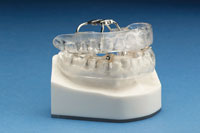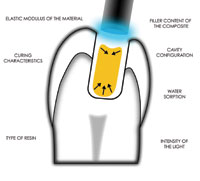Behcet’s disease is an autoimmune disorder characterized by a chronic relapsing vasculitis. Its first symptoms are usually numerous painful oral aphthous ulcers. These can be followed by acne-like skin lesions and later inflammatory eye problems. Without treatment, the disease may progress to include arthritic and neurologic manifestations. While it is considered a rare disease in the United States, it is one of the major causes of acquired blindness in Turkey (80 to 300 cases per 100,000), Japan (8 cases per 100,000), the Middle East, and Far East.1,2 It is also called Adamantiades disease or the Old Silk Route disease since its prevalence follows the route taken by silk traders from the Orient through the Middle East to Turkey and Greece.3
Although the disease has a genetic component and has been linked to HLA(Human Leukocyte Antigen)-B5,4-6 it may have an environmental trigger possibly of microbial or chemical origin. Behcet’s disease may be more common in males,7 but the data are not consistent on this issue. Treatment is aimed at immunosuppression and may include steroids, cytotoxic agents chlorambucil and cyclophosphamide, cyclosporin A, tacrolimus, colchicine, interferon alpha,8,9 pentoxyfylline,10 thalidomide,11 azathioprine, and methotrexate.
The dental professional should be aware that the presence of numerous oral aphthae could be the first symptom of Behcet’s disease. Early identification is important since early treatment can delay the onset of or prevent serious multi-organ sequelae, including neurologic and cardiovascular complications.
DIAGNOSIS
Because presenting symptoms of other autoimmune diseases such as lupus, multiple sclerosis, and Crohns disease can be similar, specific criteria exist for a diagnosis of Behcet’s disease,12,13—numerous oral ulcers plus 2 of the following: inflammation of the front (anterior uveitis) or back (retina) of the eye (posterior uveitis); skin or genital lesions; and a positive skin pathergy test.
ORAL ULCERS
 |
| Figure 1. Typical aphthous ulcer on the mucosal surface of the lower lip caused by trauma from an orthodontic bracket on a lateral incisor. |
Usually the first manifestation of Behcet’s disease, oral ulcers can occur in groups or as isolated lesions and can vary in size. They are typically round, well defined, painful, and last 7 to 10 days (Figure 1). Present primarily on the gingiva, lips, buccal mucosa, and tongue, they can also occur on the palate, tonsils, and pharynx, and can be induced by trauma. For a diagnosis of Behcet’s disease, these lesions must recur at least 3 times in a year. Genital ulcers can occur anywhere in the genital or peri-anal area and are similar in appearance to the oral lesions.
EYE LESIONS
Inflammation in the front of the eye (anterior uveitis) can present as redness with burning or clouding of vision, while posterior uveitis in the retina can cause blurred vision or aching inside the eye. In one study, 75% of patients who did not receive treatment lost their sight in a mean of 3.5 years.13
SKIN LESIONS
 |
| Figure 2. Skin lesions on the anterior surface of the leg. |
Skin lesions may present as erythema nodosum (deep red, acne-like pustules) on the anterior surface of the legs, acneform lesions or pseudofolliculitis (more superficial inflammation around the hair follicle) on the back and face, and migratory thrombophlebitis.14 (Figure 2) The skin pathergy test involves a skin puncture by a physician with a small sterile needle to incite inflammation. A positive result is formation of a pustule at the site in 24 to 48 hours.15
OTHER SYMPTOMS
Behcet’s can also incite central nervous system inflammation involving the meninges, resulting in headaches, stiff neck, fever, and meningitis. Vaso-occlusive inflammation can cause strokes. The knees, ankles, elbows, and wrists are especially prone to Behcet’s arthritis, although it is not known why and is usually not crippling. The gastrointestinal tract is usually not involved, but inflammation of the colon can cause diarrhea, constipation, bloody stools, and abdominal pain. Fever, cold sweats, and chills often occur. Blood tests may demonstrate increased levels of C-reactive protein, an inflammatory marker, increased neutrophil and platelet counts,16 increased immunoglobulins, IL-8, serum amyloid A, and beta-2 microglobulin.17
TREATMENT
While many patients seek relief for individual symptoms, systemic management of the inflammatory process is essential. If not managed systemically, the inflammation will often progress, involving tissues that were previously unaffected. As oral aphthae in young adults 25 to 35 years old are the first presenting sign in over 90% of cases,18 the astute dental clinician can contribute to the initial diagnosis. Management of oral lesions can be accomplished with a mouthrinse consisting of hydrocortisone powder 60 mg, tetracycline HCl 1.5 g, and hydramine elixer 200 mL (Benedryl). Skin and eye lesions are frequently the second presenting sign, and if left untreated, central nervous system, connective tissue, and gastrointestinal involvement may follow. For acute episodes, a systemic steroid (prednisone) can help, but long-term steroid treatment is not viable because of side effects. Immunosuppressive treatment with cyclosporin A has shown promise in clinical studies as has the immunomodulator interferon alpha 2A, which suppresses gamma delta T cells and stimulates natural killer cell cytotoxicity.8,9 Regular blood tests are necessary to check for an appropriate level of immunosuppression as well as to monitor liver and kidney functions to prevent organ damage from drug toxicity.
CASE HISTORY
The following case history is representative of patients presenting with Behcet’s disease. The patient, a female, was of English descent who had a noncontributory family history. Aphthous ulcers appeared at the age of 18, which gradually progressed to involve the tongue, gingiva, palate, and buccal mucosa. Often, she could not eat solid food and had to ingest a liquid diet. The ulcers were exacerbated by stress and lack of sleep. At age 20, she began feeling chronically fatigued, and at the same time began experiencing other systemic symptoms, including cold sweats, chills, and fever.
Her primary care physician suggested bed rest. A year later, leg cramps began, which made walking difficult. Erythema nodosa lesions appeared on her face, arms, and the anterior surfaces of her legs. Her physician then diagnosed mononucleosis, while other physicians were unable to define the problem. Without treatment, her manifestations worsened. She lost weight (15 pounds) from not eating and developed aseptic meningitis, which required hospitalization. She also had genital ulcers.
After 5 years of misdiagnoses, she saw a rheumotolgist, who diagnosed Behcet’s disease. She was started on prednisone and colchicine. While she experienced classic symptoms of chronic steroid use, including weight gain and facial rounding, the Behcet’s disease was controlled.
At present, the patient reports occasional acute episodes but has avoided hospitalizations. Another physician has begun interferon therapy with alpha 2A. She continues to use colchicine and prednisone when a flare-up occurs.
CONCLUSION
Behcet’s disease is caused by an autoimmune process that is manifested as a chronic relapsing vasculitis and is associated with potentially serious complications, especially if left untreated. Many patients and some dentists and physicians still confuse the oral aphthae of Behcet’s disease with oral herpetic lesions. The dental professional should be at the forefront in terms of diagnosing and explaining Behcet’s disease to the patient and should be comfortable referring patients to a rheumatologist for general medical management.
References
1. Mishima S, Masuda K, Izawa Y, et al. The eighth Frederick H. Verhoeff Lecture. Presented by Saiichi Mishima, MD. Behcet’s disease in Japan: ophthalmologic aspects. Trans Am Ophthalmol Soc. 1979;77:225-279.
2. Yazici H. Behcet’s syndrome. In: Klippel JH, Dieppe PA, eds. Rheumatology. London, England: Mosby; 1994:6.20.1-6.20.6.
3. Burton-Kee JE, Mowbray JF, Lehner T. Different cross-reacting circulating immune complexes in Behcet’s syndrome and recurrent oral ulcers. J Lab Clin Med. 1981;97:559-567.
4. Lee S, Bang D, Lee E-S, Sohn S, eds. Behcet’s Disease: A Guide to Its Clinical Understanding. Berlin, Germany: Springer Verlag; 2001:17.
5. Ono S, Aoki K, Sugiura S, et al. Letter: HL-A5 and Behcet’s disease. Lancet. 1973;2:1383-1384.
6. Yazici H, Chamberlain MA, Schreuder I, et al. HLA antigens in Behcet’s disease: a reappraisal by a comparative study of Turkish and British patients. Ann Rheum Dis. 1980;39:344-348.
7. Chajek T, Fainaru M. Behcet’s disease. Report of 41 cases and a review of the literature. Medicine (Baltimore). 1975;54:179-196.
8. Alpsoy E, Yilmaz E, Basaran E. Interferon therapy for Behcet’s disease. J Am Acad Dermatol. 1994;31:617-619.
9. K—tter I, Eckstein AK, St—biger N, et al. Treatment of ocular symptoms of Behcet’s disease with interferon a2a: a pilot study. Br J Ophthalmol. 1998;82:488-494.
10. Yasui K, Ohta K, Kobayashi M, et al. Successful treatment of Behcet disease with pentoxifylline. Ann Intern Med. 1996;124:891-893.
11. Gardner-Medwin JM, Smith NJ, Powell RJ. Clinical experience with thalidomide in the management of severe oral and genital ulceration in conditions such as Behcet’s disease: use of neurophysiological studies to detect thalidomide neuropathy. Ann Rheum Dis. 1994;53:828-832.
12. International Study Group for Behcet’s Disease. Criteria for diagnosis of Behcet’s disease. Lancet. 1990;335:1078-1080.
13. Mamo JG. The rate of visual loss in Behcet’s disease. Arch Ophthalmol. 1970;84:451-452.
14. Ersoy F, Berkel A, Firat T, et al. HLA antigens associated with Behcet’s Disease. In: Dausset J, Svejgaard A, eds. HLA and Disease. Baltimore, Md: Williams & Wilkins; 1977.
15. Koc Y, Gullu I, Akpek G, et al. Vascular involvement in Behcet’s disease. J Rheumatol. 1992;19:402-410.
16. Yazici H, Chamberlain MA, Schreuder I, et al. HLA antigens in Behcet’s disease: a reappraisal by a comparative study of Turkish and British patients. Ann Rheum Dis. 1980;39:344-348.
17. Hooper PL, Rao NA, Smith RE. Cataract extraction in uveitis patients. Surv Ophthalmol. 1990;35:120-144.
18. Ammann AJ, Johnson A, Fyfe GA, et al. Behcet syndrome. J Pediatr. 1985:107:41-43.
Dr. Georgaklis is a general dentist in Boston and a lecturer in adult cosmetic orthodontics. He can be reached at (617) 277-5200.









